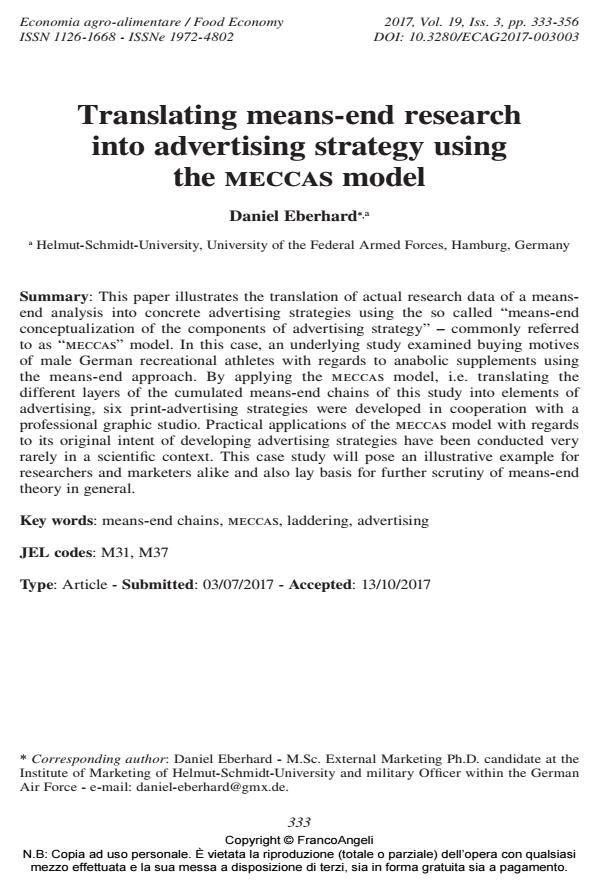Translating means-end research into advertising strategy using the meccas model
Titolo Rivista ECONOMIA AGRO-ALIMENTARE
Autori/Curatori Daniel Eberhard
Anno di pubblicazione 2017 Fascicolo 2017/3
Lingua Inglese Numero pagine 24 P. 333-356 Dimensione file 292 KB
DOI 10.3280/ECAG2017-003003
Il DOI è il codice a barre della proprietà intellettuale: per saperne di più
clicca qui
Qui sotto puoi vedere in anteprima la prima pagina di questo articolo.
Se questo articolo ti interessa, lo puoi acquistare (e scaricare in formato pdf) seguendo le facili indicazioni per acquistare il download credit. Acquista Download Credits per scaricare questo Articolo in formato PDF

FrancoAngeli è membro della Publishers International Linking Association, Inc (PILA)associazione indipendente e non profit per facilitare (attraverso i servizi tecnologici implementati da CrossRef.org) l’accesso degli studiosi ai contenuti digitali nelle pubblicazioni professionali e scientifiche
This paper illustrates the translation of actual research data of a meansend analysis into concrete advertising strategies using the so called "means-end conceptualization of the components of advertising strategy" - commonly referred to as "meccas" model. In this case, an underlying study examined buying motives of male German recreational athletes with regards to anabolic supplements using the means-end approach. By applying the meccas model, i.e. translating the different layers of the cumulated means-end chains of this study into elements of advertising, six print-advertising strategies were developed in cooperation with a professional graphic studio. Practical applications of the meccas model with regards to its original intent of developing advertising strategies have been conducted very rarely in a scientific context. This case study will pose an illustrative example for researchers and marketers alike and also lay basis for further scrutiny of means-end theory in general.
Parole chiave:Means-end chains, meccas, laddering, advertising
Jel codes:M31, M37
- What motivates customers to purchase from social commerce pages? A means-end chain approach Pranay Sindhu, Kumkum Bharti, in Information Technology & People /2025
DOI: 10.1108/ITP-10-2022-0735 - Driving participation and investment in B2B trade shows: The organizer view Roberto Mora Cortez, Wesley J. Johnston, Srinath Gopalakrishna, in Journal of Business Research /2022 pp.1092
DOI: 10.1016/j.jbusres.2022.01.028 - Methodological considerations on the means‐end chain analysis revisited Fleur B. M. Kilwinger, Ynte K. van Dam, in Psychology & Marketing /2021 pp.1513
DOI: 10.1002/mar.21521
Daniel Eberhard, Translating means-end research into advertising strategy using the meccas model in "ECONOMIA AGRO-ALIMENTARE" 3/2017, pp 333-356, DOI: 10.3280/ECAG2017-003003